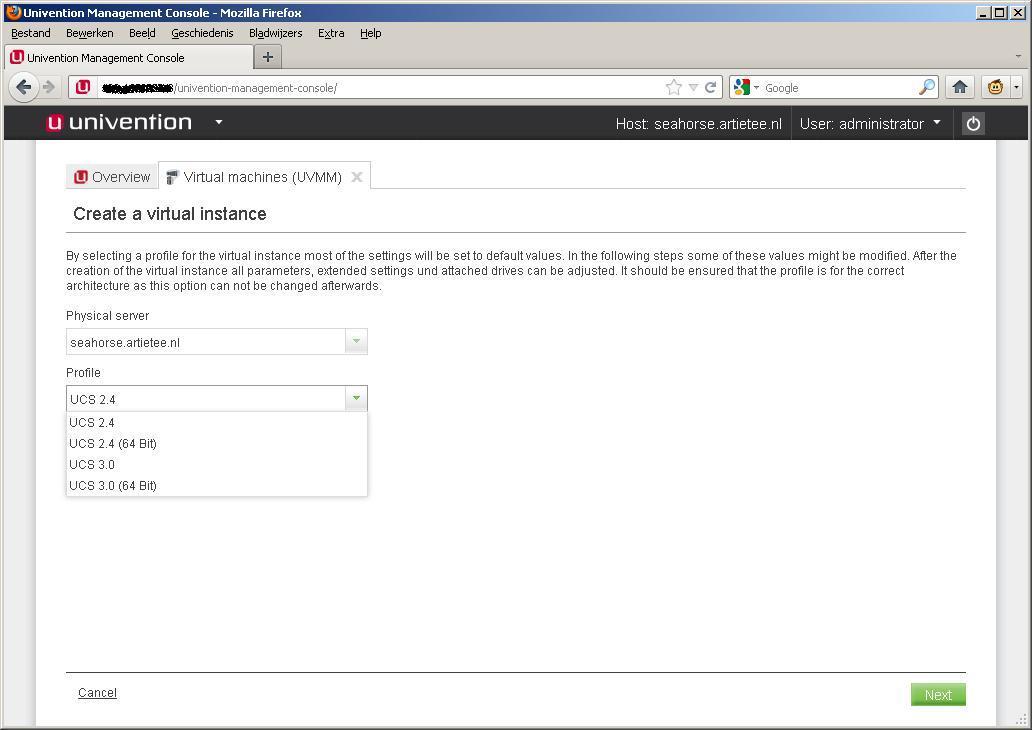Testing UCS3.0. A newly installed domain master controller with UVMM and XEN. The only visible VM-profiles are UCS 24 and UCS 30.

Where did I go wrong?
Regards,
Arthur

Testing UCS3.0. A newly installed domain master controller with UVMM and XEN. The only visible VM-profiles are UCS 24 and UCS 30.

Where did I go wrong?
Regards,
Arthur
Hello,
can you please check wether the system provides the necessary CPU-flag for virtualisation? Please note, that the system should be bootet with a normal kernel, not the XEN Hypervisor Kernel, to perform this command.
egrep --color 'svm|vmx' /proc/cpuinfoIf the system does not support full virtualisation, the templates for MS Windows Operating System are not shown, as these cannot be installed paravirtualised. You may check the BIOS Settings of the machine to be sure that CPU Virtualisation is enabled.
Kind Regards,
Tobias Scherer
This machine does not have the necessary CPU-flags for virtualization and I don’t have the intention to run any kind of MS Windows OS on this machine. I would like to install Debian. The 4 profiles that are present only allow me to install different versions of UCS. I uploaded some Debian iso-images to the server. But when I use one of the UCS-profiles I end up with an error as soon as I try to boot the new VM.

Hello,
the profiles in UVMM are used to set common default values for RAM, CPU-Count, 32/64bit, etc. - there should be no problem using a UCS profile for installing Debian.
You can easily create own profiles in the UMC.
Please go to “Navigation -> Virtual Machine Manager -> Profiles -> xen -> Add UDM object -> UVMM: Profile”
Did you receive this failure after an installation or directly after creating the instance and booting it for the first time?
Could you please explain the way you created the instance (harddisk, settings, etc.)?
Please also attach “/var/log/libvirt/qemu/.log” and “/var/log/univention/virtual-machine-manager-daemon-errors.log” here.
Kind Regards,
Tim Petersen
Hello,
under “Navigation > Virtual Machine Manager > Profiles > xen” I see all the pre-defined profiles. Most profiles (except for the UCS-profiles) are using “Full virtualization (XEN)”. I created a new profile (using “Paravirtualization (XEN)” and also the para-virtual driver for hard drives, network interface and CDROM drives). The new profile is available in the UVMM.
In the UVMM I create a new virtual instance using this profile and I add 2 drives. The first one is a CD/DVD-ROM drive that uses an existing image (debian-6.0.4-i386-CD-1.iso) from the default pool. The second drive is a hard drive that creates a new image in the default pool in simple format (raw).
In "/var/log/univention/virtual-machine-manager-daemon-errors.log " I see:
libvir: Xen error : Domain not found: xenUnifiedDomainLookupByName
libvir: Storage error : Storage volume not found: no storage vol with matching path
libvir: Storage error : Storage volume not found: no storage vol with matching name ‘deb-32-test-0.raw’
Back in the UVMM I start the new virtual instance. Almost immediately I get the Notification (see previous message).
In "/var/log/univention/virtual-machine-manager-daemon-errors.log " I see:
libvir: Xen Daemon error : POST operation failed: xend_post: error from xen daemon: (xend.err “Boot loader didn’t return any data!”)
It is interesting to note that the new virtual instance does boot when I replace the debian-6.0.4-i386-CD-1.iso with UCS_2.4-0-amd64.iso (the virtual hardware architecture was set to “Automatic” in the profile). I tried different debian iso images.
No idea (yet) where to go from here. Maybe a stock iso image from Debian is not the way to go?
Regards, Arthur
Hello,
the debian installation discs are using syslinux instead of grub for booting. In an paravirtualized environment, XEN is using pygrub to determine the kernel, initrd, etc.
So, while using syslinux or other bootloaders instead of grub, pygrub/xen cannot determine the correct way to boot the iso. Thats the reason why booting the UCS iso is no problem - we are using grub there.
You can try different things:
[ul]
[li]You can try to specify the Kernel, initrd, etc. via virsh. You can use the following command:
sudo virsh edit <name of the instance>Please have a look at libvirt documentation at Direct Kernel Boot for further information.
You also have to verify, that the debian iso image comes with a xen pv kernel.[/li]
[li]Use KVM instead of XEN - you could use the virtio drivers then for paravirtualization later on.[/li]
[li]Use Hardware that supports full virtualization.[/li][/ul]
Kind regards,
Tim Petersen